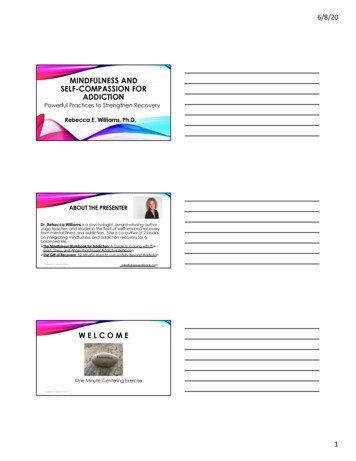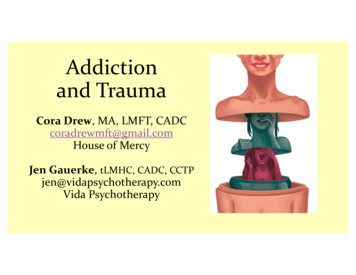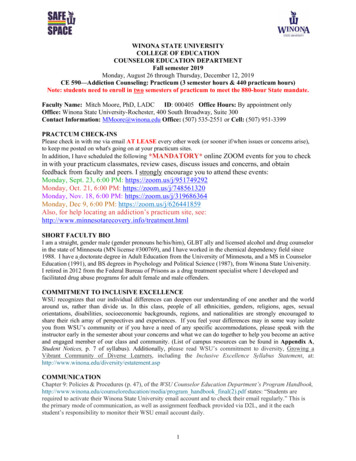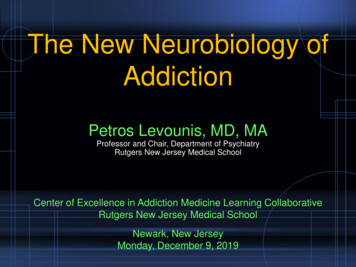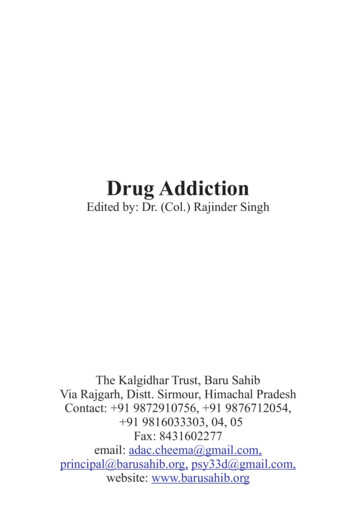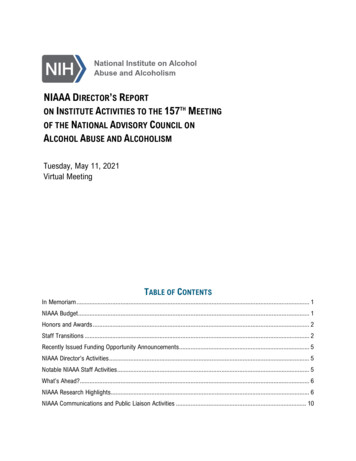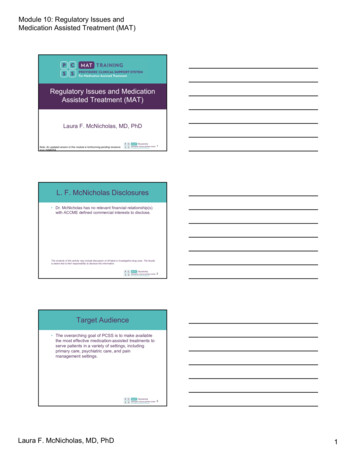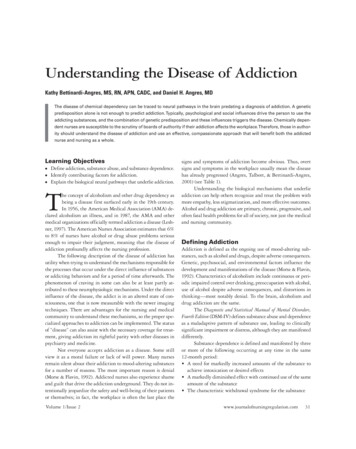
Transcription
Understanding the Disease of AddictionKathy Bettinardi-Angres, MS, RN, APN, CADC, and Daniel H. Angres, MDThe disease of chemical dependency can be traced to neural pathways in the brain predating a diagnosis of addiction. A geneticpredisposition alone is not enough to predict addiction. Typically, psychological and social influences drive the person to use theaddicting substances, and the combination of genetic predisposition and these influences triggers the disease. Chemically dependent nurses are susceptible to the scrutiny of boards of authority if their addiction affects the workplace. Therefore, those in authority should understand the disease of addiction and use an effective, compassionate approach that will benefit both the addictednurse and nursing as a whole.Learning ObjectivescccDefine addiction, substance abuse, and substance dependence.Identify contributing factors for addiction.Explain the biological neural pathways that underlie addiction.The concept of alcoholism and other drug dependency asbeing a disease first surfaced early in the 19th century.In 1956, the American Medical Association (AMA) declared alcoholism an illness, and in 1987, the AMA and othermedical organizations officially termed addiction a disease (Leshner, 1997). The American Nurses Association estimates that 6%to 8% of nurses have alcohol or drug abuse problems seriousenough to impair their judgment, meaning that the disease ofaddiction profoundly affects the nursing profession.The following description of the disease of addiction hasutility when trying to understand the mechanisms responsible forthe processes that occur under the direct influence of substancesor addicting behaviors and for a period of time afterwards. Thephenomenon of craving in some can also be at least partly attributed to these neurophysiologic mechanisms. Under the directinfluence of the disease, the addict is in an altered state of consciousness, one that is now measurable with the newer imagingtechniques. There are advantages for the nursing and medicalcommunity to understand these mechanisms, so the proper specialized approaches to addiction can be implemented. The statusof “disease” can also assist with the necessary coverage for treatment, giving addiction its rightful parity with other diseases inpsychiatry and medicine.Not everyone accepts addiction as a disease. Some stillview it as a moral failure or lack of will power. Many nursesremain silent about their addiction to mood-altering substancesfor a number of reasons. The most important reason is denial(Morse & Flavin, 1992). Addicted nurses also experience shameand guilt that drive the addiction underground. They do not intentionally jeopardize the safety and well-being of their patientsor themselves; in fact, the workplace is often the last place theVolume 1/Issue 2signs and symptoms of addiction become obvious. Thus, overtsigns and symptoms in the workplace usually mean the diseasehas already progressed (Angres, Talbott, & Bettinardi-Angres,2001) (see Table 1).Understanding the biological mechanisms that underlieaddiction can help others recognize and treat the problem withmore empathy, less stigmatization, and more effective outcomes.Alcohol and drug addiction are primary, chronic, progressive, andoften fatal health problems for all of society, not just the medicaland nursing community.Defining AddictionAddiction is defined as the ongoing use of mood-altering substances, such as alcohol and drugs, despite adverse consequences.Genetic, psychosocial, and environmental factors influence thedevelopment and manifestations of the disease (Morse & Flavin,1992). Characteristics of alcoholism include continuous or periodic impaired control over drinking, preoccupation with alcohol,use of alcohol despite adverse consequences, and distortions inthinking—most notably denial. To the brain, alcoholism anddrug addiction are the same.The Diagnostic and Statistical Manual of Mental Disorders,Fourth Edition (DSM-IV) defines substance abuse and dependenceas a maladaptive pattern of substance use, leading to clinicallysignificant impairment or distress, although they are manifesteddifferently.Substance dependence is defined and manifested by threeor more of the following occurring at any time in the same12-month period: A need for markedly increased amounts of the substance toachieve intoxication or desired effects A markedly diminished effect with continued use of the sameamount of the substance The characteristic withdrawal syndrome for the substancewww.journalofnursingregulation.com31
Table 1Recognizing Addiction in the WorkplaceTypically, the workplace is the last place the signs and symptoms of addiction become obvious. Changes in mood, behavior,and appearance may be gradual or sudden. The signs andsymptoms of addiction include:c frequent tardiness and absenteeismc poorly explained accidents and injuriesc relationship discord: marital, family, professionalc deterioration in personal appearancec significant weight loss or gainc long sleeves and tinted glasses inappropriate for the settingc overuse of cologne and breath freshenersc severe mood swings or change in personalityc withdrawal from family, friends, and coworkers—forexample, refusing social invitationsc frequent disappearances during work hoursc smell of alcohol on breath during work hoursc too much time spent with opiates, or missing opiatesc dilated or pinpoint pupilsc extra work shifts to obtain substances. The same substance taken to relieve or avoid withdrawal symptoms The substance taken in larger amounts or over a longer periodthan was intended A persistent desire or unsuccessful efforts to cut down or control substance use A great deal of time spent in activities needed to obtain thesubstance, use the substance, or recover from the effects Reduction in or absence of important social, occupational, orrecreational activities because of substance use Continued substance use despite knowledge of a persistent orrecurrent physical or psychological problem caused or exacerbated by the substance.Substance abuse is defined and manifested by one or moreof the following in a 12-month period: Recurrent substance use resulting in a failure to fulfill majorrole obligations at work, school, or home Recurrent substance use in situations in which it is physicallyhazardous Recurrent substance-related legal problems Continued substance use despite persistent or recurrent socialor interpersonal problems caused or exacerbated by the effectsof the substance.Substance dependence and abuse are differentiated for diagnostic purposes, but often treated similarly by clinicians. Dependence is the more severe diagnosis, but substance abuse canlead to substance dependence.Causes of AddictionA percentage of the population has a biogenetic predisposition32Journal of Nursing Regulationto chemical or addictive behaviors; however, early-life traumaticexperiences, such as isolation or abuse, can contribute to a predisposition to addiction. A predisposition alone is generally notenough to cause the disease. Often, a person is influenced bysocial factors, such as peers and societal and familial norms, andpsychological issues, such as a history of physical or sexual abuse,other trauma, and dual diagnosis.Dual DiagnosisA common dual diagnosis for addicts and alcoholics is anxietydisorder. Chemical dependency is a primary disease, however,and is not caused by other diseases. Both diagnoses must betreated fully and equally. The only issue is the use of addictingsubstances to treat a chemically dependent person, which mayfuel the addiction—for example, treating anxiety disorder withbenzodiazepines. A person with a dual diagnosis needs continuityof care and caregivers who understand addiction.GeneticsFamilial transmission of alcoholism risk is in part geneticallyinduced. Animal studies show that specific alcohol-related traits,such as sensitivity to intoxication and sedative effects, development of tolerance and withdrawal, and even susceptibility toorgan damage, can have genetic origins. Studies of family illnesses, twins, and adoption support a genetic contribution toalcoholism. The Human Genome Project is also contributingto our understanding of the role of genetics in alcoholism. TheNational Institute on Alcohol Abuse and Alcoholism’s (NIAAA)Collaborative Study on the Genetics of Alcoholism discoveredreduced brain-wave amplitude that reflects an underlying geneticvariation in the brain’s response to alcohol (NIAAA, 2003).The findings regarding alcoholism have generally held truefor substance abuse and addicting behaviors. For example, peoplewith an exaggerated response to alcohol (van den Wildenberg etal., 2007) and opiates may have low beta-endorphin levels. Thestronger urge to drink in the alcoholic may be related to the Gallele that predisposes people to drug use in general (Gianoulakis,Krishnan, & Thavundayil, 1996). In his 2003 editorial in TheAmerican Journal of Psychiatry, “A Predisposition to Addiction:Pharmacokinetics, Pharmacodynamics, and Brain Circuitry,” Dr.Peter Kalivas (2003) states, “There is little doubt that the development of addiction to drugs of abuse is in part a function ofpredisposing factors in an individual’s genome as well as factorsassociated with childhood and adolescent development” (p. 160).Research points to the commonality of all addictive processes,whether the addiction is to a substance or a behavior.The Addictive Personality: Does it Exist?Despite many discussions regarding an addictive personality,research indicates that the personalities of alcoholics are heterogeneous. Certain personality problems, such as impulsivity andpoor coping skills, can result from early developmental problems,
but these personality deficits can also result from addiction. Thatis, addiction can interfere with the way people see themselves,cope with stress, and interact with others. Sometimes, determining whether personality problems are primary or secondary to addiction must wait until the addict is sober for an extended period.From a psychological perspective, Khantzian and Mackhave described “the heavy reliance on chemical substances torelieve pain, provide pleasure, regulate emotions, and create personality cohesion.” They have described this process as self-governance, and although no specific addictive personality may beidentifiable, the maladaptive personality functioning in addictioncreates a need for a cohesive sense of self and strategies to enhanceself-governance capabilities. (Khantzian and Mack, 1983)Deficits in the neurochemistry and reward circuitry in addiction, such as dopamine synthesis, likely influence personalityin addicted patients. Some speculate that these circuits evolvedin the brain for purposes of social attachment and are activatedin addiction. It seems logical that the strong connection thatcan occur among sober addicts plays a pivotal role in addictionrecovery. Conversely, disorders that disrupt these attachmentand affiliative systems, such as borderline personality disorder,can pose significant challenges to the treatment of addiction.In all probability, adaptive styles occur at different timesin the addictive process. Before the addiction, a deficit in rewardcapacity could create a feeling of deprivation, leading to cravingstates and mood instability. During active substance use, previous temperament styles are exaggerated, and because of ongoingaddiction, character development is arrested.Nurses at RiskThe risk to nurses is the same as it is for the general population, except for one thing: Nurses have better access to opiates.This accessibility, coupled with the culture of relieving painwith mood-altering substances, can create an ideal environmentfor a person who is genetically predisposed to addiction. Thus,nurses with a significant family history of addiction should eitherabstain from working with opiates or have an awareness of thepotential for danger and incorporate stress-reducing behaviorsinto their lifestyle as a prevention. Currently, no one can predictif a person will become addicted in his or her lifetime.Reward Circuitry of the BrainThe mesolimbic pathways connect the brainstem and peripheral nervous system responsible for automatic body functions,and the limbic areas of the brain responsible for emotions tothe prefrontal cortex, where thinking and decision making takeplace. Intellectually, people know that happiness does not comein a bottle, pill, or morsel. Unfortunately, the brain’s rewardcircuitry does not know it. In fact, what underlies addiction isreward (see Figure 1).Volume 1/Issue 2Figure 1Reward Circuitry of the BrainThe reward circuitry of the brain involves the mesolimbicdopamine system, including the prefrontal cortex, the nucleusaccumbens, and the ventral tegmental areas (VTAs).PrefrontalcortexNucleusaccumbensVTAReward is the term neuroscience uses to describe experiences that bear repeating, such as pleasure or relief from somediscomfort. Neuroscience has come a long way in identifyingthe areas of the brain involved in reward and the neurochemistry of our feel-good chemicals that create reward responses.Neurotransmitters, such as dopamine and beta-endorphins, facilitate communication to the reward center. In the addict, thepathway involved in essential behaviors, such as eating, sleeping,and sex, is hijacked. The addict’s initial motivation is to feelpleasure. Eventually, the reward pathway shifts its sensitivitiesto the substance or behavior instead of the neurotransmitters.In other words, the brain begins to depend on outside chemicalsfor reward.Magical ConnectionThe predisposed brain of the addict is like a lock, and the addicting substance or behavior is the key. When the key opensthe lock the first time, the experience is extremely powerful,even magical. In the mid-1990s, positron emission tomography(PET) scans showed that the brain’s reward circuitry in peoplewith a previous or family history of addiction lit up in a way thereward circuitry of those in control groups did not. These studiesand others demonstrate that addicts experience their substancesmore intensely than nonaddicts. Other studies suggest that addicts run “two quarts low in feel-good chemistry” and then experience an exaggerated response when they find their drug—aphenomenon called “the magical connection.” Now, advancedtechniques, such as PET scans and magnetic resonance imaging(MRI), can scientifically demonstrate this phenomenon.Many addicts describe this initial experience as finallyfeeling normal. Sometimes, a paradoxical response occurs. Forexample, an opiate that typically causes sedation instead produceswww.journalofnursingregulation.com33
Figure 2Vicious Circle of AddictionBio-genetic predisposition,or repeated exposureDopamine and endorphinPotential reactivity“Two quarts low”Initial useDesperation useExaggerated rewardMemory of experiencestored“Running on empty”Maintenance useRelative withdrawal(psychological and/or physical)Impaired decision makingContinued useDepletion of receptorsToleranceImpaired learningEscalation of useAttempts to capture initialuse experienceFurther depletionDecreased motivationstimulation and increased energy. This response helps explainwhy many health-care professionals addicted to oral analgesicsdescribe a feeling of being more alert. Consequently, they feelthey can work more hours and even be more effective at whatthey do, thus feeding their denial. This initial connection is relatively short-lived. Invariably, a vicious circle takes over. In thepursuit of reward, the receptors that naturally mediate rewardbecome desensitized, which creates the need for more substances,contributing to tolerance and withdrawal. The more addicts use,the more they need, creating the progressive, vicious circle thatis the hallmark of all addictions (see Figure 2).Learning and MemoryHyman (2005) discusses the role of addictive behaviors in usurping the neural mechanisms of learning and memory that normally shape survival behaviors related to rewards and predictive cues.If survival is too intimately associated in the addict’s mind withsecuring the addictive substance, rewards and predictive cuesdevelop around the substance. Chronic substance use results inimpaired reward-related learning (Koob & Kreek, 2007). Addictsmay believe that the hedonic properties of the substance far exceed other goals and devote their lives to attaining the substance.Dopamine, a powerful neurotransmitter, can shape stimulus-reward learning, or the behavioral response to reward-relatedstimuli. Cueing involves significant associational memories, andconnectionist brain theory suggests that these associations arewired into the brain. For example, a patient placed in an environment where he or she previously used a substance may bevulnerable to an emerging pattern of brain stimuli and connec34Journal of Nursing Regulationtions that can motivate the patient to use again.This research suggests a circular pattern of reinforcementwith diminished capacity for the addict to incorporate new learning strategies. Addicts are trapped in a system of drug acquisition and the consistent reward pattern of ingestion. Awarenessof other rewarding stimuli or the need to invest energy in otherrewarding activities decreases. More often, addicts maintain alimited consciousness of the destructive and alienating cyclesof addiction and only enter treatment because of a consequenceof their use, such as a spouse’s threat to leave, a job intervention, licensing problems, or legal difficulties. Addicts rarely seektreatment because of insights into their behavior and addiction.A person with an addictive disease who has engaged inchronic substance use maintains a series of intact or collaboratively fragmented memories of the addictive behaviors and likelyrecalls these memories with ease during periods of craving. Inearly recovery, memories of successful sobriety and newly learnedbehaviors do not have the same level of intensity; thus, they arevulnerable to being overridden. Also, addicts experience a periodcalled post-acute withdrawal in early sobriety. The most commonsymptoms are lack of concentration, irritability, and insomnia.MotivationMotivation is another factor with biological components, and pursuit of goals that produce desired outcomes is an integral aspectof addiction and recovery. Kalivas and Volkow (2005) supportthe theory that addiction involves a dysregulation in the motivecircuitry, and the repetitive use of addictive drugs reorganizesbrain circuitry to establish behaviors characteristic of addiction.MRI studies on cue-induced craving demonstrate increased reaction between the amygdala, the fear-based part of the brain,and the prefrontal cortex when people are actively remindedof their addicting agent. The prefrontal cortex, responsible fordecision making, gets activated with the amygdala, creating aconnection for craving. This activates a neurotransmitter calledglutamate, which creates an unpleasant feeling associated withcraving that can cause the addict to try to reduce this discomfortthrough drug use.Besides the legal, financial, and psychosocial consequencesof addictive behavior, the addict also risks neuronal recircuitingthat results in physiologic cycles of addictive behaviors. Thesecircuits are increasingly difficult to break.Decision MakingAddictive behaviors negatively affect decision making, as well.Noel, van der Linden, and Bechara (2006) suggest that addiction is an imbalance between the neural system that is reactivefor signaling pain or pleasure and another neural system that isreflective and controls the reactive system. When the ventromedial prefrontal cortex (VMPC) is injured in nonaddicts, they
make detrimental decisions and fail to learn from their mistakes,contrary to their pre-injury personality. The authors make striking comparisons between patients with VMPC injuries and addicts. Both deny they have a problem and appear to ignore theconsequences of their actions. In addiction, the neural mechanisms that enable people to reflect and choose wisely appear tobe weakened, and addicts move from self-directed behavior toautomatic sensory-driven behavior. The study's authors hypothesize that some people have a weak decision-making mechanismin the brain and that the weakness makes them vulnerable toaddiction. The source of the weakness can be genetic or environmentally induced.Recent MRI studies demonstrate a split between the ability to make appropriate decisions as the compulsive drive for thechemical or addiction progresses. Goldstein and Volkow (2002)demonstrated that as addiction progresses, one’s ability to makeappropriate choices diminishes. Increased impulsivity is accompanied by memories of when the addiction worked as well asnegating options other than engaging in the addiction. Not onlyare some people predisposed to a sluggish reward circuitry beforeever using a substance, they also appear to have some degree ofdifficulty in decision making. Deficits in these areas constitutethe vicious circle of addiction.Denial, the close companion of addiction, feeds off theprogressive deterioration of the ability to freely choose. Denialis reinforced by the powerful reward of the addiction and thedeficits in learning, motivation, memory, and decision making.ConclusionAddiction is a biopsychosocial disease process, not a choice. Martha Morrison, MD, in her book White Rabbit, stated that shegrew up wanting to be a physician, not a drug addict. Alcoholicand addicted nurses unanimously report the same sentiments.If appropriately treated, addiction can remain in remission,and nurses who have peer support and monitoring have a greaterchance of long-term sobriety than the general population. Therecovering addict must begin an exploration into self, cultivate aprogram of well-being, and maintain a long-term goal of sobriety.The bodies of authority in the nursing profession mustunderstand the disease of addiction and its treatment. This understanding may lead to more options for addicted nurses, greateropportunities for them to heal and return to the profession, anda compassionate approach to peers that is congruent with thevalues of the nursing profession.Gianoulakis, C., Krishnan, B., & Thavundayil, J. (1996). Enhanced sensitivity of pituitary beta-endorphin to ethanol in subjects at highrisk of alcoholism. Archives of General Psychiatry, 53, 250–257.Goldstein, X. R., & Volkow, N. D. (2002). Drug addiction and its underlying neurobiological basis: Neuroimaging evidence for involvement of the frontal cortex. American Journal of Psychiatry,159(10), 1642–1652.Hyman, S.E. (2005). Addiction: A disease of learning and memory.American Journal of Psychiatry,162, 1414–1422.Kalivas, P. (2003). A predisposition to addiction: Pharmacokinetics,pharmacodynamics, and brain circuitry. American Journal of Psychiatry, 160(1), 1–2.Kalivas, P. W., & Volkow, N. D. (2005). The neural basis of addiction:A pathology of motivation and choice. American Journal of Psychiatry, 162(8), 1403–1413.Khantzian, E. J., & Mack, J. E. (1983). Self-preservation and the careof the self—ego instincts reconsidered. Psychoanalytic Study of theChild, 38, 209–232. New Haven, CT: Yale Univetrsity Press.Koob, G., & Kreek, J. (2007). Stress, dysregulation of drug rewardpathways, and the transition to drug dependence. American Journalof Psychiatry, 164(8), 1149–1159.Leshner, A. (1997). Addiction is a brain disease, and it matters. Science,278(5335), 807–808.Morse, R., & Flavin, D. (1992). The definition of alcoholism. JAMA,268(8), 1035–1039.NIAAA. (2003). The genetics of alcoholism. Alcohol Alert, No. 60. Retrieved from el, X., van der Linden, M., & Bechara, A. (2006). The neurocognitive mechanisms of decision making, impulse control, and loss ofwill power to resist drugs. Psychiatry, 3(5), 30–41.van den Wildenberg, E., Wiers, R. W., Dessers, J., Janssen, R. G. J. H.,Lambrichs, E., H., Smeets, H. J. M., & van Breukelen, G. J. P.(2007). A functional polymorphism of the u-opioid receptor gene(ORPMI) influences cue-induced craving for alcohol in male heavydrinkers. Alcoholism, Clinical and Experimental Research, 31(1),1–10. doi: 10.1111/j.1530-0277.2006.00258.xKathy Bettinardi-Angres, MS, RN, APN, CADC, and Daniel H.Angres, MD, are clinicians in the field of addiction with a focus onhealth-care professionals.ReferencesAngres, D., Talbott, D., & Bettinardi-Angres, K. (2001). Healing TheHealer: The Addicted Physician. Madison, CT: The PsychosocialPress.Volume 1/Issue 2www.journalofnursingregulation.com35
PosttestUnderstanding the Diseaseof AddictionLearning Objectivesc Define addiction, substance abuse,and substance dependence.c Identify contributing factors foraddiction.c Explain the biological neural path-ways that underlie addiction.CeCE PosttestUnderstanding the Disease ofAddictionIf you reside in the United States andwish to obtain 1.6 contact hours ofcontinuing education (CE) credit, pleasereview these instructions.InstructionsGo online to take the posttest and earncontinuing education (CE) credit:Members – www.ncsbninteractive.org(no charge)Nonmembers – www.learningext.com( 15 processing fee)If you cannot take the posttest online,complete the print form and mail it tothe address (nonmembers mustinclude a check for 15, payable toNCSBN) included at bottom of form.Provider accreditationThe NCSBN is accredited as a providerof CE by the Alabama State Board ofNursing.The information in this CE does notimply endorsement of any product,service, or company referred to in thisactivity.Contact hours: 1.6Posttest passing score is 75%.Expiration: July 201336Journal of Nursing RegulationPlease circle the correct answer.1. Which of the following is defined as theongoing use of mood-alteringsubstances or behaviors despite adverseconsequences?a. Dual diagnosisb. Substance dependencec. Substance abused. Addiction2. Which of the following is a criterion ofsubstance abuse according to theDiagnostic and Statistical Manualof Mental Disorders, FourthEdition (DSM-IV)?a. Characteristic withdrawal syndrome forthe substanceb. Markedly diminished effect withcontinued use of the same amount of thesubstancec. Recurrent substance use in situations inwhich it is physically hazardousd. The same substance is taken to relieve oravoid withdrawal symptoms3. Which statement about predisposition toaddiction is correct?a. A percentage of the population has abiogenetic predisposition to chemical oraddictive behaviors.b. A predisposition is usually enough tocause the disease.c. Early childhood experiences have littleinfluence on the manifestation ofaddiction.d. Studies of family illnesses, twins, andadoption do not support a geneticcontribution to opioid abuse.4. The stronger urge to drink in thealcoholic may be related to:a. the C allele.b. the G allele.c. high beta-endorphin levels.d. high alpha-endorphin levels.5. The risk for addiction in nurses:a. is lower than that for the generalpopulation.b. is higher than that for the generalpopulation.c. is the same as the general population.d. depends on the nurse’s specialty.6. Which statement about the rewardcircuitry of the brain is correct?a. Neurotransmitters facilitatecommunication to the reward center.b. Neurotransmitters inhibit communicationto the reward center.c. The reward circuitry of the brain includesthe prone tegmental areas.d. The reward circuitry of the brain involvesthe limbic epinephrine system.7. Which statement about the mesolimbicpathway is correct?a. It connects the brainstem and peripheralnervous system responsible forautomatic functions, and the limbic areasof the brain responsible for emotions tothe frontal cortex.b. It connects the brainstem and peripheralnervous system responsible forautomatic functions, and the limbic areasof the brain responsible for emotions tothe prefrontal cortex.c. It connects the peripheral nervoussystem responsible for automaticfunctions and the limbic areas of thebrain responsible for emotions to theprefrontal cortex.d. It connects the brainstem responsible forautomatic functions, and the limbic areasof the brain responsible for emotions tothe frontal cortex.8. Which neurotransmitter can shapestimulus-reward learning?a. Alpha-endorphinb. Norepinephrinec. Epinephrined. Dopamine9. Which statement about addicts andtreatment is correct?a. Addicts usually do not enter treatmentbecause of a consequence of thesubstance use.b. Addicts rarely seek treatment because ofinsights into their behavior and addiction.c. Abstinence from the substance is usuallysufficient treatment for an addict.d. Isolation from other recovering addicts isa helpful treatment strategy.10. Which neurotransmitter causes theunpleasant feeling associated withcraving?a. Norepinephrineb. Epinephrinec. Glutamated. Dopamine
11. Which of the following is NOT a commonsymptom of post-acute withdrawal inearly sobriety?a. Sleepinessb. Lack of concentrationc. Irritabilityd. Insomnia12. Magnetic resonance imaging studiesshow that cue-induced craving inaddicts is associated with increasedreaction between the:a. posterior cortex and ventral tegmentalarea.b. prefrontal cortex and nucleusaccumbens.c. amygdala and posterior cortex.d. amygdala and prefrontal cortex.13. Injury to which area in a nonaddictedperson results in decision makingsimilar to that of the addicted person?a. Ventromedial prefrontal cortexb. Ventromedial posterior cortexc. Lateral prefrontal cortexd. Lateral posterior cortex14. Continued use of an addicting substancecauses:a. depletion of receptors.b. improved learning.c. decreased tolerance.d. enhanced decision making.Evaluation Form (required)3. Were the methods of presentation (text,tables, figures, etc.) effective?1. Rate your achievement of eachobjective from 5 (high/excellent)to 1 (low/poor).c Define addiction, substance abuse, andsubstance dependence.12345Identify contributing factors foraddi
Volume 1/Issue 2 www.journalofnursingregulation.com 31 Learning Objectives cefine addiction, substance abuse, and substance dependence.D cdentify contributing factors for addiction.I c Explain the biological neural pathways that underlie addiction. T he concept of alcoholism and other drug dependency as being a disease first surfaced early in the 19th century.


